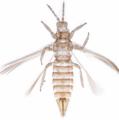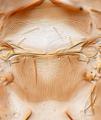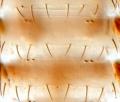Neohydatothrips burungae
Recognition data
Distinguishing features
Both sexes fully winged. Body yellow with light brown markings, ocellar region brown, also pronotal "blotch", tergites II–VII with brown areas laterally and antecostal ridge dark; fore wing uniformly pale grey. Antennae 8-segmented, III–IV with short forked sensorium. Head with 3 pairs of ocellar setae, pair III within or on margins of ocellar triangle; median postocular setae about as long as distance between posterior ocelli; mouth cone extending between fore coxae. Pronotum with transverse striae on anterior half, "blotch" with striae closely spaced, posteroangular setae 50 microns. Metanotum with striations transverse at anterior, longitudinal medially. Fore wing first vein setal row complete but penultimate seta displaced to posterior. Abdominal tergites II–V median setae with distance between their bases scarcely twice diameter of setal pore; VII–VIII with posteromarginal comb of microtrichia complete and long. Sternites with many rows of microtrichia medially.
Related and similar species
Mound & Marullo (1996) considered this species a variant and synonym of Neohydatothrips signifer (Priesner). However, N. signifer is possibly a different species known only from the original specimens collected in Mexico. These Mexican type specimens of N. signifer have the hind tibiae more distinctly brown medially than in samples of N. burungae from Mexico, and the comb of microtrichia on the posterior margin of tergite VII is shorter than that on tergite VIII rather than subequal in length. In California, N. burungae is also similar to N. setosus, but has the postermarginal cilia on the sternites more than 0.5 as long as the marginal setae. The genus Neohydatothrips is found in many parts of the world and almost 100 species are included. Identification keys are available to 13 species recorded from Central America (Mound & Marullo, 1996), and Stannard (1968) treats 11 species from Illinois, but many of the 35 species described from the USA north of Mexico (Nakahara, 1988) remain poorly defined.
Taxonomic data
Current valid name
Neohydatothrips burungae (Hood)
Original name and synonyms
- Sericothrips burungae Hood, 1935: 150
- Sericothrips mimosae Hood, 1955: 134
Family placement
Thripidae, Sericothripinae
Biological data
Life history
Breeding on the leaves of its host plant.
Host plants
Persea americana (Lauraceae); also taken from Tagetes minuta (Asteraceae) in Brazil, Citrus (Rutaceae) in California, and cultivated Passiflora (Passifloraceae) in Colombia.
Tospoviruses vectored
None
Crop damage
Distortion to young leaves of Passiflora in Colombia.
Distribution data
Area of origin
Central America
Distribution
California, Panama, Honduras, Nicaragua, Guatemala, Costa Rica, Jamaica, Mexico, Colombia, Brazil.







